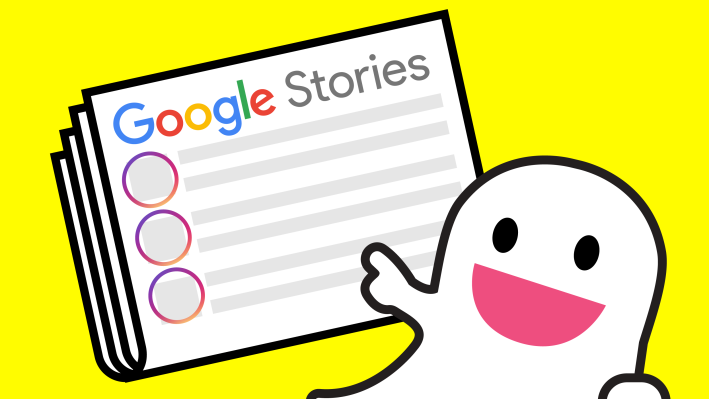Snapchat has a new ally or enemy depending on how you look at Google’s new mobile magazine format, but the social app is welcoming the search giant. Google’s clone of Snapchat Discover, called AMP Stories, officially launched today, allowing news outlets to create photo/video slideshows that appear in mobile search results and on their site.
Suddenly, Snapchat isn’t the only place to show off Discover-style content.
In response to Google’s launch, Snapchat’s VP of Content Nick Bell told TechCrunch, “Our ambition at Snapchat is to empower great storytelling, and we think we have pioneered the best format for doing that on mobile. We’re delighted to see that an industry is starting to form around that, and hope that it will encourage more newsrooms to invest in teams that focus on made-for-mobile content.”
Snapchat refused to detail whether it demands exclusivity from Discover publishers and forbids them from reusing the content elsewhere, which was its policy when Discover launched in 2015. But Bell’s quote implies that Snapchat sees the opportunity for more publishers to adopt the format if they can reuse content from Discover and port in content from AMP Stories.
There are still a lot of big questions, like how prominently Google will feature AMP Stories in search, whether Google will offer powerful tools for creating them and how advertising revenue splits will be handled. There are no ads in AMP Stories yet, even though the format has been in testing since August. But the biggest question is how publishers and advertisers will react to having multiple places to show their animated ‘zines.
There are two ways I see this going. The reality is it will likely be a mix of both, though I think the opportunities outweigh the threats for Snapchat.
The threat: Google steals content and ads from Snapchat
Having the world’s most popular advertising and information platform barge into your business should be at least a little unnerving.
On the content side, Snapchat won’t have a monopoly on placement of Discover-style content. That weakens its negotiating position when striking deals with publishers. Previously, after building up a team to create the visual articles, publishers didn’t have anywhere to go, so they were largely stuck with Snapchat’s revenue split terms unless they were willing to fire or reassign the staff.
Snapchat now won’t necessarily have exclusivity on content created for Discover, as publishers might seek to host it on their sites and promote it in search through Google AMP Stories. This comes at a time when Snapchat’s peer-to-peer Stories have been copied by Facebook’s apps and Discover remains one of its most differentiated features.
If Snapchat refuses to let publishers reuse Discover content on AMP Stories, it could piss off news outlets, disincentivize investment in producing top-notch content or push them to pick Google over Snapchat.
Meanwhile, advertisers will have more inventory to exploit for vertical video ads, potentially reducing the rates of Snapchat’s ads. Google’s scale and relationships with advertisers could allow it to lure dollars away from Snapchat Discover.
But… the fact is that Google and Snapchat have very different audiences. Snapchat’s users skew much younger than Google’s. Most advertisers would want to reach one demographic or the other or both. So it’s unlikely that Google AMP Stories would directly cannibalize Snapchat Discover ad revenue. That’s why I think Google’s arrival looks more like…
The opportunity: Google recruits more publishers to Discover’s format
Think of it like Google building its own brand of VCR in the early days of videotapes. Snapchat might not want competition for its own VCR, but if Google convinces more movie studios to make videotapes, the rising tide of the format could lift all boats.
Publishers have had to put a lot of trust in Snapchat Discover until now. If they built up a content creation team, and then Snapchat lost popularity or buried the Discover feature or monetization didn’t go well, the news outlet had no alternative. And once they made the content, there was nowhere else to put it.
Now, publishers have a hedge in case Snapchat stumbles. They’ll still be able to show their Discover content elsewhere. And with more viewing opportunities and chances to earn ad money to recoup their investment, publishers could pour more resources into creating high-quality visual articles.
The opportunity to sell ads against the content twice could convince more publishers to dive into the format. Snapchat earned more than $100 million for its content partners in 2017, but Google AMP could grow the ads pie for the whole format. And pulling in recycled content from Snapchat could be a boon to AMP Stories, since publishers could start experimenting with it without gambling a big investment on the success of Stories in search.
Exploiting this opportunity might require Snapchat to loosen its grip on publishers, and officially allow them to reuse content on AMP Stories. If it wanted a compromise, it could window Discover content, requiring it to stay exclusive to its platform for 24 hours or longer. Snapchat could still tout its high-performance native mobile apps as a better way to consume the content than the mobile web.
The whole equation could change if Facebook and Instagram develop their own version of Discover. Snapchat might have to clamp down and insist on exclusivity then as Instagram offers a similar demographic of audience, though that would risk publishers choosing Facebook’s apps over it.
But for now, Snapchat could view Google as an ally against Facebook and Instagram. If they can popularize the vertical slideshow mobile magazine format together, publishers might envision the dollar signs necessary to staff up Discover/AMP Stories content teams.
